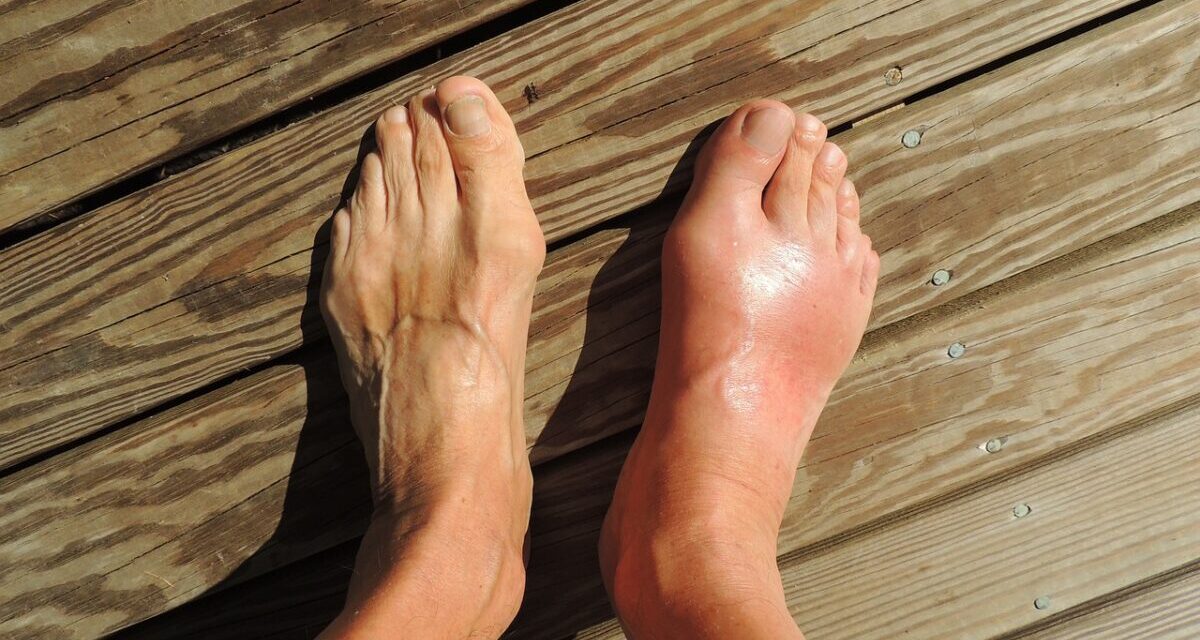While centuries ago gout mainly affected the wealthy, upper class (see the case of the English lords or our King Matthias), today it can occur in all social strata due to the sedentary lifestyle and the abundant food available. In fact!
Since the really rich people protect their health with special and, of course, very expensive diets, the average person lives on pizza, French fries, hamburgers, soft drinks, and more often struggles with being overweight.
Gout mainly occurs in overweight men, in women it can appear more after menopause (estrogen also has the effect of reducing uric acid levels).
The essence of gout is that the body fluids become oversaturated with uric acid, so crystals are released from it and deposited in various tissues. Typically, the joints and their surroundings are affected, but the kidneys and blood vessels are also damaged. Uric acid is the end product of purine metabolism, it comes from the breakdown of nucleic acids (from external and internal sources). The breakdown of purine that comes in with food to uric acid mostly takes place in the epithelial cells of the small intestine. In case of overproduction or reduced secretion of uric acid, the uric acid produced builds up in the body.
However, it is a misconception to think that high uric acid levels are necessarily associated with gout symptoms. A high uric acid level is a warning sign during a laboratory test, it should be treated, but it does not mean a disease in itself. However, it is a prelude to the development of very painful and life-threatening gout, in which genetic factors play the same role (increased production or reduced excretion) as obesity (metabolic syndrome), increased purine intake (see below) or excessive alcohol consumption (this increases the excretion of uric acid reduces).
The disease is characterized by extremely strong joint pain, the joint swells and turns red (typically the big toe, this is a beautiful old Hungarian name for the podagra), and movement is limited. It usually affects one joint, but it can affect several joints. After several attacks, the joint deforms, its movement becomes restricted, and the pain becomes permanent. In the long term, the crystals deposited in the kidneys cause kidney failure, kidney stones, high blood pressure by disease of the blood vessels, and accelerated atherosclerosis.
Gout and high uric acid levels can also develop in a secondary way (not external intake) as a result of the deterioration of kidney function, certain medications, treatments, and cancer.
A gout attack can also be triggered by heavy physical work and cold weather, in addition to a meal rich in meat soaked in alcohol.
We have a number of medications available for treatment, but now, in addition to medication, we will be talking about essential lifestyle changes and diet. As a result of the correct and consistent diet, the complaints are alleviated, the seizures are reduced and become preventable. The essence of the diet is that the diet is low in energy and purines.
In addition to reducing purine-containing foods in the diet, it is also important to reduce the amount of fats.
The purine content is reduced to 100-200 mg, while 600-1000 mg is consumed during traditional nutrition. The consumption of pork, beef, fish, poultry and game must be limited. It is advisable to cover the need for animal protein with skimmed milk, dairy products and eggs. You should also know that fats provoke a gout attack because they increase the level of uric acid indirectly.
In the nutritional composition of the diet, we recommend the following:
• Calories: 1500-2000 kcal
• Protein: 80-90g
• Fat: 50-60 g
• Carbohydrate: 200-250g
In the diet, it is not advisable to use substances whose purine content exceeds 100 mg per 100 g.
Foods with a very high purine content (over 150 mg/100 g)
Veal gland, asparagus, offal, yeast, meat extracts, steak juice, chicken breast, goose, sardines, mussels, trout, herring, fish roe, salmon, tuna, mackerel, shrimp, smoked meats, smoked fish, sunflower seeds, peanuts, raisins, liver, cocoa, chocolate.
Foods with a high purine content (75-150 mg/100 g)
Pork, beef, veal, lamb, turkey, chicken legs, duck, rabbit, deer, venison, bacon, hot dogs, sausages, smoked ham, salami, cod, carp, dry beans, yellow peas, lentils, soy, poppy seeds.
Foods with medium purine content (40-75 mg/100 g)
Flounder, green peas, cauliflower, broccoli, green beans, sea bream, tofu, cereal flakes.
Foods with a low purine content (below 40 mg/100 g)
White flour and products made from them, vegetables, fruits, eggs, milk, kefir, yogurt, cheese, sour cream, cottage cheese, butter, potatoes, pistachios, coconut, walnuts, almonds, rice, oil, margarine, honey, not yet listed.
Usable foods and food preparation procedures:
Meats, meat products
Lean pork, beef and veal can be prepared as boiled, steamed or steamed mincemeat in the amount of 100 g per day. Baking should be avoided, as the resulting substances contain large amounts of purine bodies.
Interiors
Not edible!
Butchery
Lean machine-made ham, ham salami, white steak, salami, cold cuts can be consumed taking into account the permitted purine content.
Milk, milk products
Skimmed cow's milk, yogurt, kefir, cow's cottage cheese, cheeses can be used as an independent food or to flavor food without restriction. Butter, cream and cream may only be used to flavor food.
Egg
It can be used as a stand-alone food and to prepare meals without restriction.
Fats
The amount of fat that can be consumed daily is 60g. If possible, use sunflower oil and margarine for food preparation. Add the oil cold to the food. Vegetable fat should be preferred over animal fat, because the former does not contain even a trace of purine. We avoid heating fats, because the resulting combustion products contain large amounts of purine bodies. It is advisable to use a Teflon pot, cooker, aluminum foil.
Flour, semolina, bread, bakery products
We can use them as an independent food, in the preparation of food, and to thicken food. An exception is pasta made with a large amount of fat (e.g. fatty, buttery, creamy pasta).
Rice, potatoes
They can be eaten freely, with the exception of potatoes fried in fat
Condiments
In English, they can be prepared as a vegetable, stuffed, stuffed, used as a salad, etc., boiled, steamed, fried and thickened with a mortar. The stir-fry can be prepared as follows: the flour is toasted dry, the oil is added without heating.
Fruits
They can be given raw or cooked without restriction.
Spices, flavorings
They can be used freely, taking into account the age.
Articles of pleasure
Tea and coffee can be consumed, alcohol consumption is prohibited.
Featured image: Illustration/Pixabay













